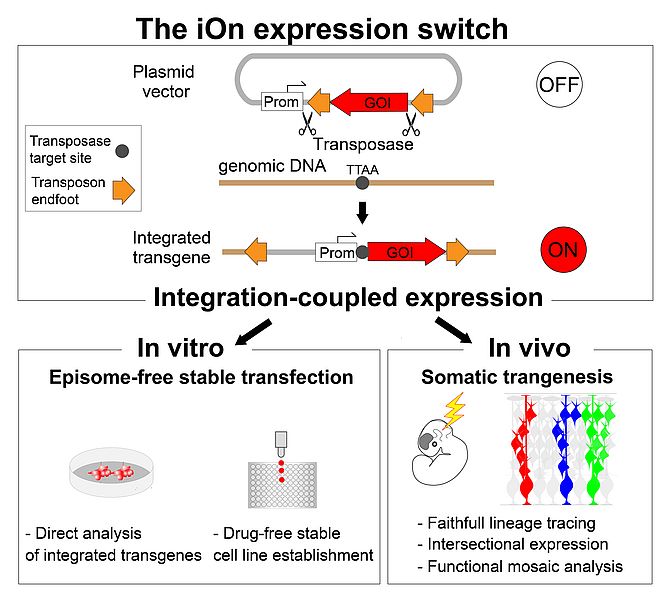The study of stem cells and their therapeutic use increasingly involve transgenic technologies, also widely employed in other fields of biology. These techniques drive the stable integration of genes of interest in the genome of the targeted cells, thus ensuring their expression over the long term. Despite the emergence of powerful molecular tools that facilitate genomic integration, transgenesis procedures face a fundamental problem: the impossibility of distinguishing between the transgenes that integrate into the genome from the much more numerous ones that do not, since both forms are active. This considerably complicates the identification of transgenic cells.
The key to the problem was to condition transgene activation to integration in the host genome. To achieve this, the researchers created a new type of "genetic switch" that couples genomic integration and expression. This system, called "iOn switch" (integration-coupled On expression switch), leads to a rearrangement of the DNA sequence of a transgene upon its incorporation into the host genome under the effect of a transposase enzyme, a tool increasingly used in transgenesis. This rearrangement triggers the expression of the gene of interest, a fluorescent marker enabling to identify the genetically modified cells. Researchers have validated this new approach in several models and species, demonstrating its effectiveness and robustness.
The iOn switch has numerous applications: in vitro, it enables to easily derive stable cell lines expressing a transgene of interest, without resorting to tedious and detrimental selection procedures based on chemical agents. In vivo, it is ideal to permanently label stem cells and follow their lineage during development, or to experimentally modulate the expression of candidate genes in order to probe their function.
The radical simplification of transgenesis enabeled by the iOn switch also opens the way to genetic manipulations that require the integration of several distinct transgenes, until now difficult to implement. This offers new possibilities for the studies of retinal development currently conducted at the Institute.
Associated publication: Direct Readout of Neural Stem Cell Transgenesis with an Integration-Coupled Gene Expression Switch, by Takuma Kumamoto, Franck Maurinot, Raphaëlle Barry-Martinet Célia Vaslin, Sandrine Vandormael-Pournin, Mickaël Le, Marion Lerat, Dragos Niculescu, Michel Cohen-Tannoudji, Alexandra Rebsam, Karine Loulier, Stéphane Nedelec, Samuel Tozer and Jean Livet




